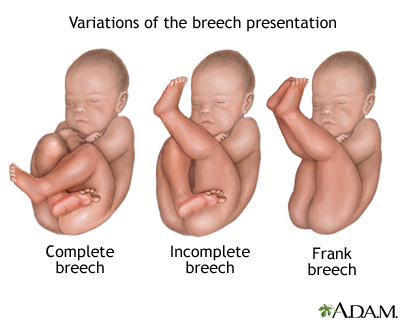Normal Position Of The Baby |
 The term "fetal presentation" refers to the part of your baby's body that is closest to the birth canal. In most full-term pregnancies, the baby is positioned head down, or cephalic, in the uterus. |
Breech Presentation |
 If your baby is breech, his bottom is the part of his body closest to the birth canal. No one is sure what causes a breech presentation, but it happens in 3% to 5% of single-baby deliveries. As your pregnancy nears full term, your caregiver will check your baby's position during regular prenatal visits. Common methods for assessing fetal position include vaginal exams, ultrasound, feeling your abdomen, and listening to the baby's heartbeat with a Doppler device. |
Types Of Breech Presentation |
 There are three types of breech presentation: complete, incomplete, and frank. Complete breech is when both of the baby's knees are bent and his feet and bottom are closest to the birth canal. Incomplete breech is when one of the baby's knees is bent and his foot and bottom are closest to the birth canal. Frank breech is when the baby's legs are folded flat up against his head and his bottom is closest to the birth canal. There is also footling breech where one or both feet are presenting. |
Complications of Breech |
 A prolapsed umbilical cord is common in breech deliveries. This happens when part of the umbilical cord slips down through the cervix before the baby does. The cord is then compressed during contractions, which cuts down on blood flow to the baby. An emergency cesarean section is usually needed. |
Correcting Breech |
 If you're near term and your baby is breech, your doctor may try to manually move him into a head-down position for delivery. There are two ways to do this: During an external version, the doctor moves your baby by pressing on the outside of your belly. During an internal version, the doctor inserts his hand through your vagina and cervix and moves the baby from the inside. If your doctor can't manually reposition your baby, a cesarean section may be needed. |
Other Presentations |
 If your baby is in a posterior position, his face is turned up toward your belly. This can make labor longer and more difficult, since the widest part of his head has to fit through the birth canal. You may be able to help your baby rotate into a normal, face-down position by getting on all fours with your bottom in the air, which allows your uterus to drop forward. Your doctor may also try to reposition your baby by reaching in through your vagina and gently rotating his head with his hand or forceps. If none of these methods works, a cesarean section may be needed. |
Other Presentations |
 If your baby is transverse, he is lying horizontally in your uterus. Your doctor may try to manually turn him into a head-down position, but a cesarean section is usually needed. |

